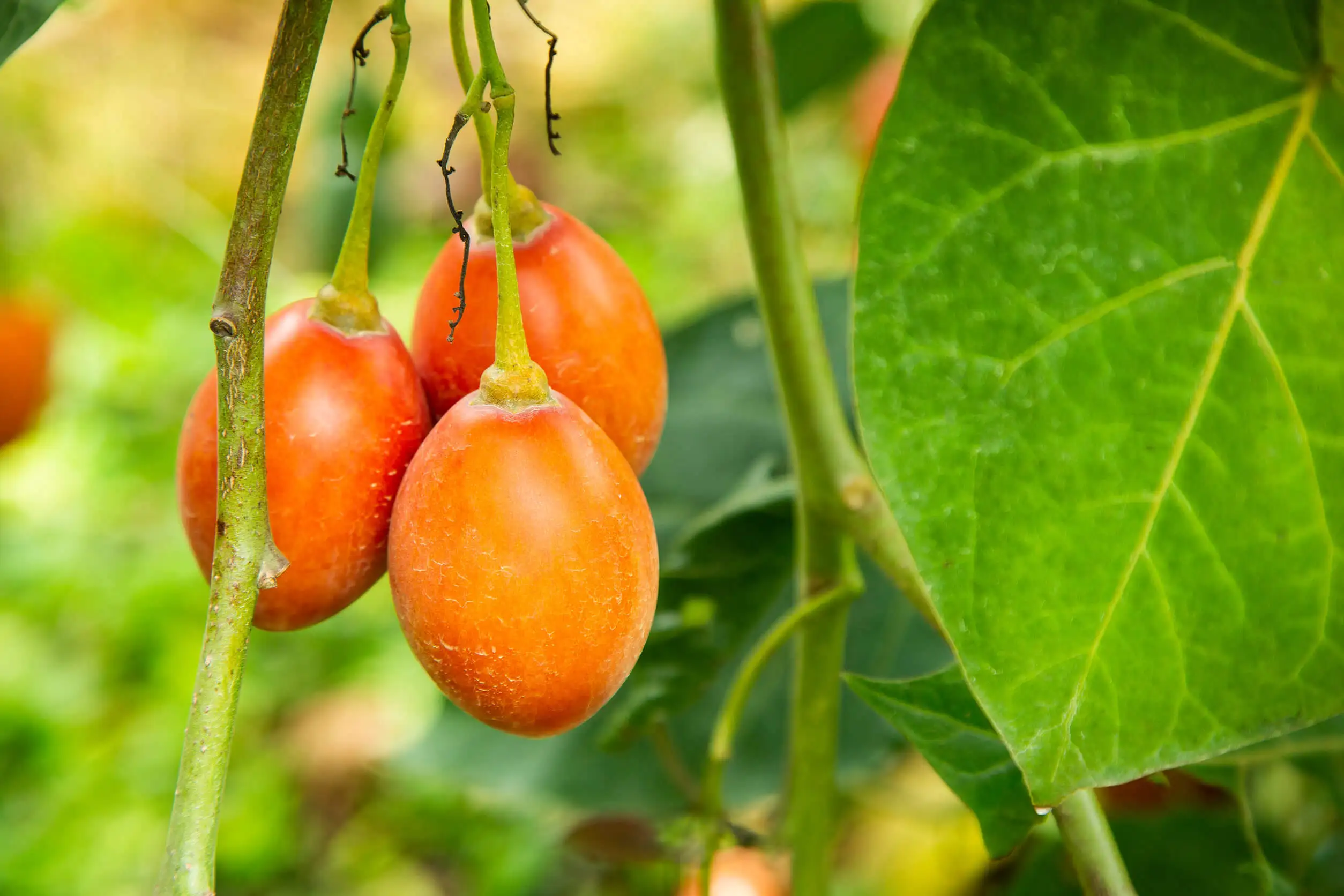6 Benefits of the Tamarillo


Written and verified by the nutritionist Anna Vilarrasa
The tamarillo is a fruit unknown to most people, but highly appreciated for its nutritional qualities. In addition, its sweet, sour, and salty taste makes it a perfect ingredient for countless recipes.
If you’re interested in discovering new, unusual foods and how they can help you maintain good health, we encourage you to continue reading this article.
The tamarillo: a small tropical treasure

The tamarillo (Solanum betaceum or Cyphomandrabetácea) is the fruit of a shrub that’s native to the Peruvian Andes. Today, the main producing countries are Peru, Colombia, Brazil, Chile, New Zealand, and South Africa, among others.
It belongs to the same family as potatoes or eggplants, but, in this case, the fruit is oval, small (between 3 and 5 centimeters, 1 to 2 inches) and orange-red in color. It has a thin skin and a juicy pulp similar to that of the tomato. It gives off a very pleasant aroma and its seeds are wrapped in a gelatinous layer with a very prominent sweet flavor.
Although it isn’t its region of origin, New Zealand was the country that made it known in the fruit market.
Properties and nutrients of the tamarillo
According to data obtained from the New Zealand Institute for Crop & Food Research, the nutritional composition per 100 grams (4 oz) of fresh product is as follows:
- Energy: 36 kilocalories.
- Protein: 1.8 grams.
- Fat: 0.5 grams.
- Carbohydrates: 4.3 grams.
- Fiber: 3.6 grams.
In addition to these, the tamarillo provides interesting components such as polyphenols, carotenes and anthocyanins. It’s also a remarkable source of vitamins A, C and B6, and of some minerals (potassium, manganese, and copper).
These compounds in the tamarillo give it a series of properties. As the authors Wang and Zhu point out, it’s an anti-inflammatory, antioxidant, antiproliferative (inhibits cell reproduction, especially of cancer cells) and anti-obesity fruit.
Because of all these characteristics, and despite the relative novelty of its cultivation, it’s believed that it may be a fruit with great potential as a health food.
The health benefits of tamarillos
Taken within the framework of a healthy and balanced diet, and in conjunction with healthy lifestyle habits, tamarillos can offer some health benefits. Some of the most outstanding are cardiovascular protection, prevention of chronic diseases and the good fiber content.
Antioxidant
The compounds with antioxidant activity protect the body against the harmful action of free radicals. The latter, when present in excess, are related to some chronic and inflammatory diseases and cellular aging.
Protector of cardiovascular health
Sodium and potassium are two electrolytes that are necessary for the proper functioning of the body, especially with regard to the cardiovascular system. Their activities are related, but they have different functions.
Experts at the Harvard School of Public Health note that high salt intake can lead to elevated blood pressure, which can cause heart problems. Potassium helps the body relax blood vessels and eliminate sodium through the kidneys, which lowers blood pressure.
The body needs more sodium than potassium. That’s why adding fruits containing potassium is good for health. On the contrary, when more sodium is ingested in relation to potassium, there’s a higher risk of death by heart attack.
Maintaining a healthy skin
The tamarillo contains some nutrients that have been recognized as beneficial for a good-looking, protected, and hydrated skin.
On the one hand, vitamin C stimulates the synthesis of collagen (a protein that is part of the skin’s structure) and plays a protective antioxidant role against UVB radiation.
In addition, the tamarillo contains vitamin A, a substance required to maintain the integrity of the mucous membranes and skin. Likewise, it helps maintain tone (prevents depigmentation), gives firmness, and elasticity and participates in the healing of wounds.
More benefits of tree tomatoes: good for eyesight
Vitamin A plays other important roles in the body, one of which has to do with eye health. It’s beneficial for health of the surface of the eye and also for the formation of the photoreceptor rhodopsin.
The latter is of particular interest with regard to night vision as it enables the eyes to see in low light conditions. In addition, some experts believe that retinol could also be involved in the onset of myopia, although at the moment more research is needed to corroborate the possible causal relationship.
Digestive aid
The tamarillo contains a good amount of fiber. One of the main benefits of its presence in the diet is the regulation of intestinal transit by improving some situations such as constipation.
Dietary fiber is also the food of the intestinal microbiota. When the undigested remains of fiber reach the colon, intestinal bacteria ferment it and give rise to a prebiotic action with some positive health effects.
Prevention of obesity, diabetes, and chronic diseases
The benefits of introducing fruit and vegetables in the diet have always been important. Beyond protection against cardiovascular diseases, in recent years research has been conducted on their relationship with other chronic and very prevalent problems such as obesity and type 2 diabetes.
Food with a good presence of fiber isn’t usually calorically dense. In addition, as studies indicate, they allow a slower gastric emptying and lead to a greater feeling of satiety. Also, they improve glucose tolerance and may be effective in lowering cholesterol.
Tamarillo – uses

The tamarillo fruit can be deceiving because of its appearance. similar to that of a small tomato. In reality, it’s a different food altogether. It is a very popular ingredient in New Zealand, Australia and India where it’s used in desserts, condiments, and main dishes.
You can eat both the pulp and the seeds, but it’s preferable to separate the skin, as it can be a bit bitter. These are some of the most common ways to consume it:
- The simplest option is to eat it fresh, on its own. To do this, cut it in half and eat the pulp with the help of a spoon. If you find the taste too acidic, sprinkle with a little sugar or sweetener.
- The pulp can be mixed in smoothies and fruit juices with banana, strawberries, oranges, or yogurt. It can also be used to make jams, jellies, and sauces.
- Sliced, it’s perfect to add to salads, toasts, sandwiches, or fruit salads. Also, it can decorate or serve as a topping on ice cream and various cakes.
The tamarillo – one more fruit for a healthy diet
The tamarillo is an unknown fruit for many people. In addition, it can be a little difficult to find and, compared to other fruits, it can be quite expensive.
The tamarillo is a delicate fruit; for this reason, at the time of purchase, it’s advisable to choose tamarillos with smooth, shiny skin and without imperfections. To check their ripeness, it should be pressed lightly with your fingers; if there’s a slight movement inwards, then it’s at the optimum point for consumption.
If they’re a little green, then keep them at room temperature to facilitate their ripening. If they’re ripe, it’s best to keep them in the refrigerator and consume them as soon as possible.
If you can buy some, we recommend you try them because their flavor and texture are surprising and delicious. Together with other assorted fruits, they provide excellent nutrients and are a perfect food for a healthy diet.
If you like plants and you feel like growing them, there’s nothing better than planting something exotic and different like the tamarillo. It’s easy to care for and very rewarding, besides being the ideal way to fully enjoy the tamarillo.
All cited sources were thoroughly reviewed by our team to ensure their quality, reliability, currency, and validity. The bibliography of this article was considered reliable and of academic or scientific accuracy.
- American Optometric Association. (2020). Vitamin A beneficial for eyes, just not preventing myopia. https://www.aoa.org/news/clinical-eye-care/health-and-wellness/vitamin-a-good-for-the-eyes?sso=y
- Carr, A. C., Maggini, S. (2017). Vitamin C and immune function. Nutrients. 9 (11): 1211. https://www.ncbi.nlm.nih.gov/pmc/articles/PMC5707683/
- Centros para el Control y la Prevención de Enfermedades. (2022). La fibra: el carbohidrato que ayuda a manejar la diabetes. U. S. Department of Helaht and Human Services. Consultado el 27 de marzo de 2023. https://www.cdc.gov/diabetes/spanish/resources/features/role-of-fiber.html
- Dayib, M., Larson, J., Slavin, J. (2020). Dietary fibers reduce obesity-related disorders: mechanisms of action. Current Opinion in Clinical Nutrition and Metabolic Care. 23 (6): 445-450. https://pubmed.ncbi.nlm.nih.gov/32925180/
- Diep, T, Pook, Ch., et al. (2020). Phenolic and anthocyanin compounds and antioxidant activity of tamarillo. (Solanum Betaceum Cav.). Antioxidants. 9 (2): 169. https://www.mdpi.com/2076-3921/9/2/169
- Gammone, M. A., Riccioni, G., et al. (2015). Carotenoids: potential allies of cardiovascular health? Food and Nutrition Research. 59: 10.3402. https://www.ncbi.nlm.nih.gov/pmc/articles/PMC4321000/
- Harvard Health Publishing. (2020). Eat more fiber-rich foods to foster heart health. Harvard Medical School. https://www.health.harvard.edu/heart-health/eat-more-fiber-rich-foods-to-foster-heart-health
- Harvard T.H. Chan. (2023). Potassium. Harvard School of Public Health. Consultado el 27 de marzo de 2023. https://www.hsph.harvard.edu/nutritionsource/potassium/
- Liguori, I., Russo, G., et al. (2018). Oxidative stress, aging and diseases. Clinical Interventions in Aging. 13: 757-772. https://www.ncbi.nlm.nih.gov/pmc/articles/PMC5927356/
- Mayo Clinic. (2022). Dietary fiber: essential for a healthy diet. https://www.mayoclinic.org/healthy-lifestyle/nutrition-and-healthy-eating/in-depth/fiber/art-20043983
- National Institutes of Health (NIH). (2022). La vitamina A y los carotenoides. Consultado el 27 de marzo de 2022. https://ods.od.nih.gov/factsheets/VitaminA-DatosEnEspanol/
- Salazar-Lugo, R., Barahona, A., et al. (2016). Efecto del consumo de jugo de tomate de árbol (Cyphomandra betacea) sobre el perfil lipídico y las concentraciones de glucosa en adultos con hiperlipidemia, Ecuador. Archivos Latinoamericanos de Nutrición.66 (2). http://ve.scielo.org/pdf/alan/v66n2/art04.pdf
- Schagen, S., Zampeli, V. A., et al. (2012). Discovering the link between nutrition and skin aging. Dermato Endocrinology. 1; 4 (3): 298-307. https://www.ncbi.nlm.nih.gov/pmc/articles/PMC3583891/
- Shah, R. A., Bakshi, P., et al. (2022). Tamarillo (Cyphomandra betacea (Gav)). Origin, cultivation, breeding and management. Tropical Plant Species and Technological Interventions for Improvement. https://www.intechopen.com/chapters/83111
- Wang, S., Zhu, F. (2020). Tamarillo (Solanum betaceum): chemical composition, biological properties and product innovation. Trends in Food Science & Technology. 95: 45-58. https://www.sciencedirect.com/science/article/abs/pii/S092422441930367X?via%3Dihub
This text is provided for informational purposes only and does not replace consultation with a professional. If in doubt, consult your specialist.








